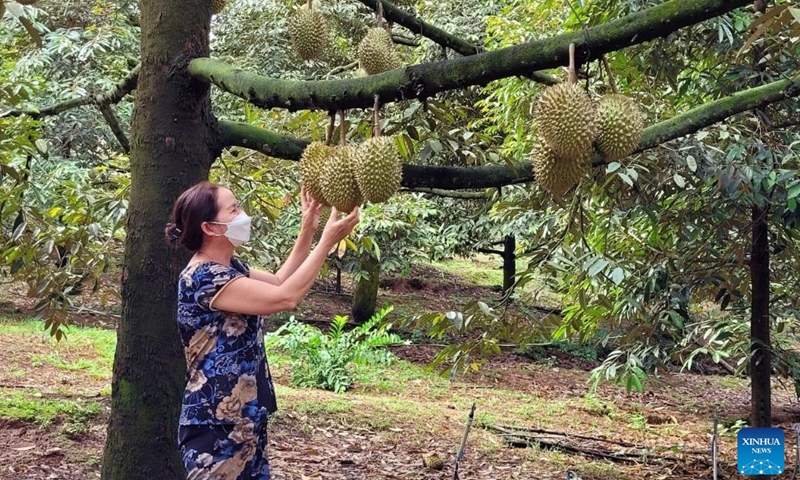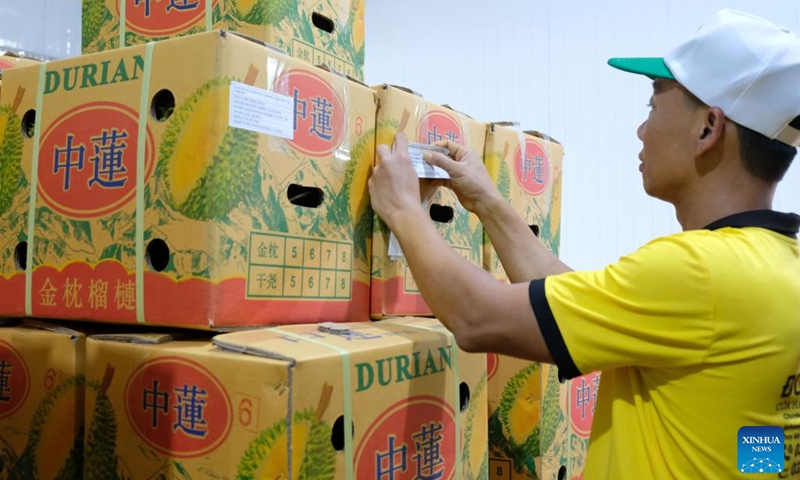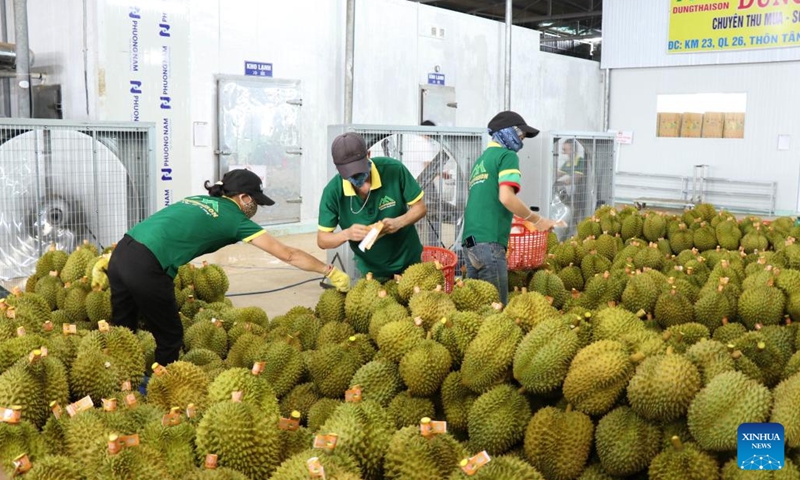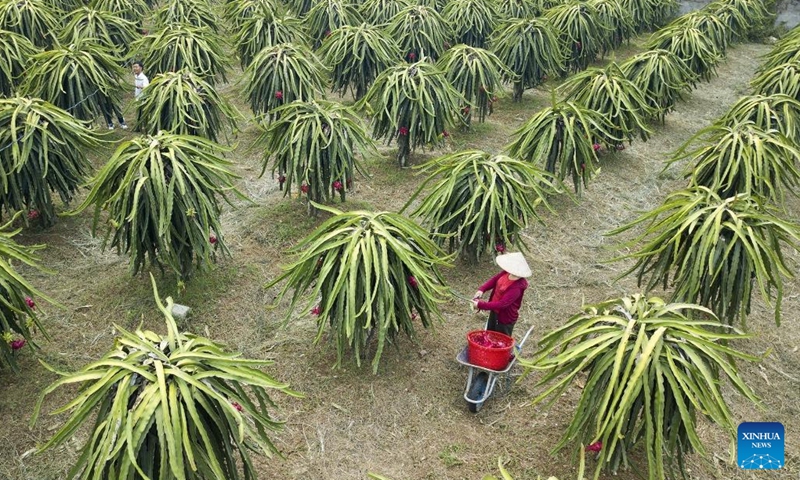
A farmer works in the Ri6 durian orchard in Chau Duc district, Ba Ria-Vung Tau province, Vietnam, on May 25, 2022.(Photo: Xinhua)

A staff member stamps label on boxes of fresh durians before exporting to China at a factory in Bao Lam district, Vietnam's central highlands Lam Dong province, on Sept. 20, 2022.(Photo: Xinhua)

Staff members put stickers on fresh durians before export to China at an export factory in Krong Pac district, Vietnam's central highlands Dak Lak province, on Sept. 17, 2022.(Photo: Xinhua)

A farmer works in a dragon fruit farm in Lac Thuy district, Hoa Binh province, Vietnam, on July 6, 2022.(Photo: Xinhua)
Despite a gloomy global picture featuring rising fuel prices and inflation, and disruptions to supply chains, two-way trade between China and Vietnam has this year achieved high growth thanks to the implementation of the Regional Comprehensive Economic Partnership (RCEP).
"Since RCEP went into effect on Jan. 1, 2022, especially after China recently allowed import of a number of Vietnamese agricultural products such as durian, bird's nest, sweet potato and passion fruit, Vietnamese enterprises nationwide, including our company, have found big opportunities to export new products to its northern neighbor," Dinh Gia Nghia, deputy general director of Dong Giao Foodstuff Export Joint Stock Company in the northern Ninh Binh province, told Xinhua in December.
To increase export turnover to RCEP member countries, including China, Vietnamese firms must innovate technology, improve designs, and improve product quality, Nghia said. "RCEP has become a launching pad for us to increase product output and quality, as well as the quantity and the value of exports."
His statement was echoed by both local farmers and officials of provinces that export fruits.
"I have just sold five tons of Ri6 durian to traders for nearly 80,000 Vietnamese dong (3.3 U.S. dollars) per kilogram, doubling the price in the same period last year, thanks to the adoption of stricter cultivation standards," said Nguyen Van Hai, a veteran farmer in Cai Lay district in the southern province of Tien Giang.
According to Nguyen Van Man, director of the Department of Agriculture and Rural Development of Tien Giang Province, the fact that Vietnamese durian has been exported to China via official channels since September is a contributing factor to higher prices and bigger volumes of the fruit shipped to the neighboring country.
The Institute of Policy and Strategy for Agriculture and Rural Development under the Vietnamese Ministry of Agriculture and Rural Development said Vietnam earned nearly 50 million dollars from exporting durian to China in October, skyrocketing 4,120 percent against the same period last year, an unprecedented increase in the history of the Vietnamese durian sector.
From Sept. 17 to Nov. 30, over 20,000 tons of the fruit were shipped to China via official channels, and the volume is estimated to surge to 30,000 tons by the end of December, said the institute.
Many Vietnamese companies are expanding material zones and improving fruit quality to boost their export to China and other RCEP members.
"We are planning to increase the number of certified fruit cultivation areas, enhancing the processing scale to have a sufficient supply of durian for export all year round, not just in season," Vu Ngoc Huy, deputy general director of Dung Thai Son Import-Export Trading Joint Stock Company in the central highlands province of Dak Lak, told Xinhua this month.
To date, the company has had 17 facilities for fruit purchasing and packing in Dak Lak and Tien Giang with more than 200 workers, Huy said, adding that its output of processed durian for export is about 50 tons a day.
Van Xuan Phat Import-Export Company in HCM City is also focusing on exporting fruits, especially durian and passion fruit, to China and other RCEP members.
"On Sept. 17, we exported the first three containers of durian. After that, every month we are to export 1,000 tons according to our partners' orders," Nguyen Vu Thang, operation director of Van Xuan Phat Import-Export Company, told Xinhua in an interview.
Nghia at Dong Giao Foodstuff Export Joint Stock Company said that on the occasion of the upcoming Lunar New Year Festival, the demand of the Chinese market will account for more than 50 percent of Vietnam's fresh fruit exports.
In 2023, Vietnam's fruit and vegetable exports to China may increase by 20 percent to 30 percent, mainly thanks to smoother transport, quicker customs clearance, lower tariffs under the RCEP arrangement, and e-commerce development, Nghia said, adding that his company is looking forward to exporting frozen durian to the neighboring country.
"Besides durian, other fruits such as passion fruit, banana, pineapple, and mango still have many opportunities for export growth to China, as long as they meet the requirements of Chinese partners, like complying with full and strict procedures from planting to harvesting, preserving and packing," he said.
The Agency of Foreign Trade under the Vietnamese Ministry of Industry and Trade shared Nghia's view, saying that fruit and veggie export turnovers are expected to become bigger in the future because durian has been allowed to enter China, the biggest importer of Vietnamese fruits and vegetables, under official quotas since September, and banana will follow suit soon, contributing to bigger overall trade between China and Vietnam.
Statistics of China's customs showed that the two countries' trade increased by 19.7 percent to 230.2 billion dollars in 2021, the first time in history surpassing the 200-billion mark despite the impacts of the COVID-19 pandemic and the staggering global economy.
Vietnam posted foreign trade value of 673.82 billion dollars in the first 11 months of this year, up 11.8 percent year on year, and China was its largest export destination, according to Vietnam's General Statistics Office.
With RCEP's implementation, trade between Vietnam and other RCEP members, including China, will further surge in the coming years, Vietnamese officials and experts said.
